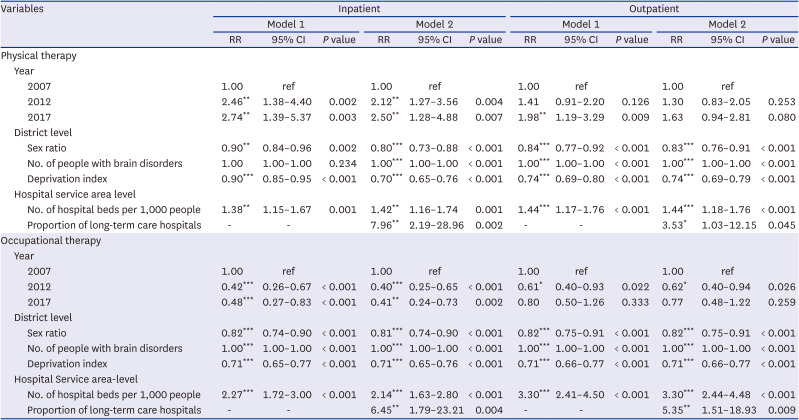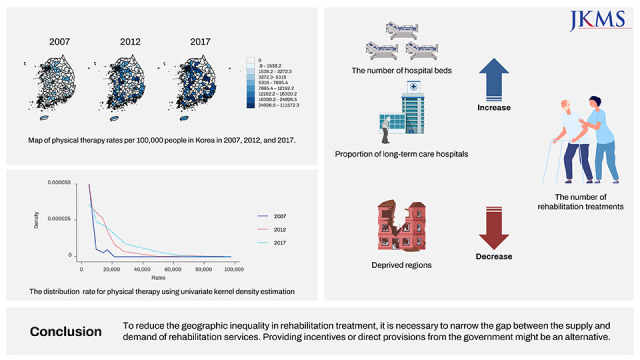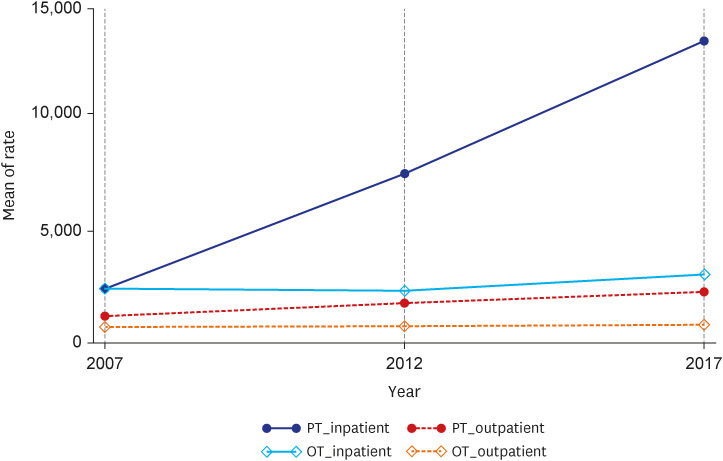1. Jørgensen HS, Nakayama H, Raaschou HO, Vive-Larsen J, Støier M, Olsen TS. Outcome and time course of recovery in stroke. Part I: outcome. The Copenhagen Stroke Study. Arch Phys Med Rehabil. 1995; 76(5):399–405. PMID:
7741608.
2. Pappalardo A, D’Amico E, Leone C, Messina S, Chisari C, Rampello L, et al. Inpatient versus outpatient rehabilitation for multiple sclerosis patients: effects on disability and quality of life. Mult Scler Demyelinating Disord. 2016; 1(1):3.
3. Mak MK, Wong-Yu IS, Shen X, Chung CL. Long-term effects of exercise and physical therapy in people with Parkinson disease. Nat Rev Neurol. 2017; 13(11):689–703. PMID:
29027544.
4. World Health Organization. Monitoring the Building Blocks of Health Systems: A Handbook of Indicators and Their Measurement Strategies. Geneva, Switzerland: World Health Organization;2010.
5. Culyer AJ. Equity - some theory and its policy implications. J Med Ethics. 2001; 27(4):275–283. PMID:
11479360.
7. Horner RD, Swanson JW, Bosworth HB, Matchar DB. VA Acute Stroke (VAST) Study Team. Effects of race and poverty on the process and outcome of inpatient rehabilitation services among stroke patients. Stroke. 2003; 34(4):1027–1031. PMID:
12624220.
8. Gao F, Foster M, Liu Y. Disability concentration and access to rehabilitation services: a pilot spatial assessment applying geographic information system analysis. Disabil Rehabil. 2019; 41(20):2468–2476. PMID:
29726287.
9. Jing Q, Tang Q, Sun M, Li X, Chen G, Lu J. Regional disparities of rehabilitation resources for persons with disabilities in China: data from 2014 to 2019. Int J Environ Res Public Health. 2020; 17(19):7319. PMID:
33036409.
10. Christensen K, Doblhammer G, Rau R, Vaupel JW. Ageing populations: the challenges ahead. Lancet. 2009; 374(9696):1196–1208. PMID:
19801098.
11. Kim YS, Lee J, Moon Y, Kim KJ, Lee K, Choi J, et al. Unmet healthcare needs of elderly people in Korea. BMC Geriatr. 2018; 18(1):98. PMID:
29678164.
12. Kim HK, Leigh JH, Lee YS, Choi Y, Kim Y, Kim JE, et al. Decreasing incidence and mortality in traumatic brain injury in Korea, 2008–2017: a population-based longitudinal study. Int J Environ Res Public Health. 2020; 17(17):6197. PMID:
32859061.
13. Jung SH. Stroke rehabilitation fact sheet in Korea. Ann Rehabil Med. 2022; 46(1):1–8. PMID:
35272435.
14. Choi Y, Kim YE, Leigh JH, Lee YS, Kim HK, Yi YG, et al. Comparison of trends in the incidence of traumatic spinal cord injury in daily life, automobile accidents, and industrial accidents: a national multi-insurance study in Korea. J Korean Med Sci. 2023; 38(7):e26. PMID:
36808542.
15. Kim KW, Kim OS. Super aging in South Korea unstoppable but mitigatable: a sub-national scale population projection for best policy planning. Spat Demogr. 2020; 8(2):155–173. PMID:
34222615.
16. Bai G, Anderson GF. A more detailed understanding of factors associated with hospital profitability. Health Aff (Millwood). 2016; 35(5):889–897. PMID:
27140996.
17. Kim AM, Kang S, Park JH, Yoon TH, Kim Y. A spatial analysis of geographic variation and factors associated with hospitalization for bacterial pneumonia in Korea. BMC Pulm Med. 2019; 19(1):45. PMID:
30786908.
18. Kim AM, Park JH, Yoon TH, Kim Y. Hospitalizations for ambulatory care sensitive conditions as an indicator of access to primary care and excess of bed supply. BMC Health Serv Res. 2019; 19(1):259. PMID:
31029134.
19. Kim AM, Park JH, Kang S, Hwang K, Lee T, Kim Y. The effect of geographic units of analysis on measuring geographic variation in medical services utilization. J Prev Med Public Health. 2016; 49(4):230–239. PMID:
27499165.
20. Kim AM, Park JH, Kang S, Yoon TH, Kim Y. An ecological study of geographic variation and factors associated with cesarean section rates in South Korea. BMC Pregnancy Childbirth. 2019; 19(1):162. PMID:
31072318.
21. Townsend P. Deprivation. J Soc Policy. 1987; 16(2):125–146.
24. Salgado-Ugarte IH, Shimizu M, Taniuchi T. Exploring the shape of univariate data using kernel density estimators. Stata Tech Bull. 1994; 3(16):
25. StataCorp. LP. Stata Multilevel Mixed-Effects Reference Manual Release 17. College Station, TX, USA: StataCorp LP;2021.
26. Moon HE. A study on small area variations of the rehabilitation service utilization in post-stroke patients [master’s thesis]. Seoul, Korea: Seoul National University;2013.
27. Leigh JH, Kim WS, Sohn DG, Chang WK, Paik NJ. Transitional and long-term rehabilitation care system after stroke in Korea. Front Neurol. 2022; 13:786648. PMID:
35432175.
28. Costa AP, Poss JW, Peirce T, Hirdes JP. Acute care inpatients with long-term delayed-discharge: evidence from a Canadian health region. BMC Health Serv Res. 2012; 12(1):172. PMID:
22726609.
29. Sonoda S, Saitoh E, Nagai S, Kawakita M, Kanada Y. Full-time integrated treatment program, a new system for stroke rehabilitation in Japan: comparison with conventional rehabilitation. Am J Phys Med Rehabil. 2004; 83(2):88–93. PMID:
14758294.
30. Kinoshita S, Abo M, Okamoto T, Miyamura K. Transitional and long-term care system in Japan and current challenges for stroke patient rehabilitation. Front Neurol. 2022; 12:711470. PMID:
35087461.
31. Sun EY, Jadotte YT, Halperin W. Disparities in cardiac rehabilitation participation in the United States: a systematic review and meta-analysis. J Cardiopulm Rehabil Prev. 2017; 37(1):2–10. PMID:
27676464.
32. Sharifi A, Kamali M, Chabok A. Rehabilitation needs of people with cerebral palsy: a qualitative study. Med J Islam Repub Iran. 2014; 28:16. PMID:
25250261.
33. Phillips KA, Morrison KR, Andersen R, Aday LA. Understanding the context of healthcare utilization: assessing environmental and provider-related variables in the behavioral model of utilization. Health Serv Res. 1998; 33(3 Pt 1):571–596. PMID:
9685123.
34. Babitsch B, Gohl D, von Lengerke T. Re-revisiting Andersen’s Behavioral Model of health services use: a systematic review of studies from 1998-2011. Psychosoc Med. 2012; 9:Doc11. PMID:
23133505.
35. Bachmann JM, Huang S, Gupta DK, Lipworth L, Mumma MT, Blot WJ, et al. Association of neighborhood socioeconomic context with participation in cardiac rehabilitation. J Am Heart Assoc. 2017; 6(10):e006260. PMID:
29021267.
36. Yong-Jae L. An study on the inequality of health care resources distribution affected by regional characteristics. J Crit Soc Welf. 2005; 21:49–78.
37. Kamenov K, Mills JA, Chatterji S, Cieza A. Needs and unmet needs for rehabilitation services: a scoping review. Disabil Rehabil. 2019; 41(10):1227–1237. PMID:
29303004.
38. Bright T, Wallace S, Kuper H. A systematic review of access to rehabilitation for people with disabilities in low- and middle-income countries. Int J Environ Res Public Health. 2018; 15(10):2165. PMID:
30279358.
39. Ministry of Health and Welfare. Ministry of Health and Welfare Statistics YearBook 2017. Sejong, Korea: 2018.
40. Ministry of Health and Welfare. Ministry of Health and Welfare Statistics YearBook 2013. Seoul, Korea: 2013.








 PDF
PDF Citation
Citation Print
Print





 XML Download
XML Download